�
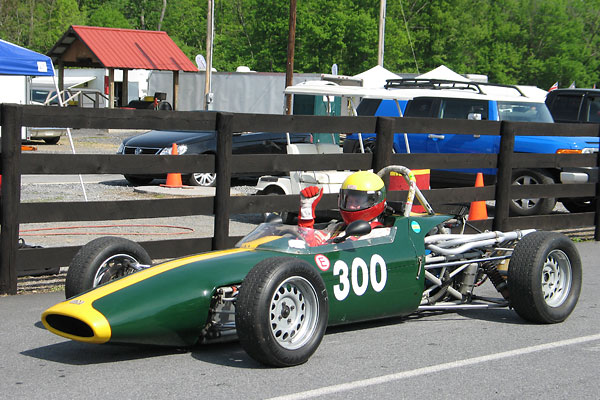
�
Robert Romanansky's Macon MR7 Formula Ford Racecar
� � Owner: Robert Romanansky� City: Mountain Top, Pennsylvania
� Model: 1969 Macon MR7
� Engine: Ford Kent 1600cc four cylinder
� Race prepared by: Tivvy Shenton�
�
Macon Race Cars
��
Angus MacPhail and Tony Houghton combined parts of their names to create�
the tradename "Macon". The two friends also combined skills to design and build�
a number of interesting racing vehicles in the late sixties and early seventies. �
�
The very first Macon was a land speed record motorcycle/sidecar combination, but the�
young company reached its stride and gained its fame in Formula Ford. Along with Lotus and �
Alexis, Macon Race Cars was one of the first firms to build cars especially for�
the newly announced and very exciting Formula Ford class. The Macon MR6 was initially�
developed in 1967. Much of the early testing was completed with Syd Fox serving as test�
driver.�
�
You might possibly recall that the very first Formula Ford race ever held (at Brands Hatch,�
July 12, 1967) was won by Ray Allen who drove a Lotus 51. Soon thereafter, Allen switched�
to a Macon MR6 and with it he continued winning races.�
The most famous Macon driver was an Australian named Vern Schuppan. After some success�
in Formula Ford with Macon sponsorship, Schuppan went on to drive Formula One and�
Indy cars. He won the Le Mans 24 hour Race in 1983, driving a Rothmans Porsche 956.�
�
�
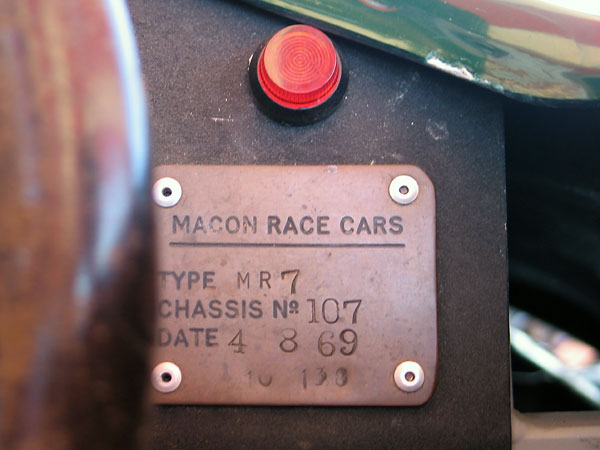
�
MACON RACE CARS
�
TYPE MR7, CHASSIS NO. 107, DATE 4 8 69, (10 138).
�
�
Macon sold a few cars to British customers in early 1968, before Tony Houghton was�
introduced to Fred Opert, the well known New Jersey based importer of racing cars. From�
that meeting on, Macon shipped most of their production to the United States. The tiny shop�
could hardly build cars fast enough. Macon Race Cars built about twenty cars between 1967 and�
1971. Thereafter, the rate of sales declined but production continued over years. Before�
Tony Houghton's death in a sailing accident, the Macon badge had been placed on about�
forty race cars.�
�
Peter Alexander of PA Motorsport acquired rights to the Macon Race Cars name in 2004, and�
from that time has been supplying genuine Macon spare parts from original molds, jigs,�
and drawings.�
�
Features and Specifications
�| Engine: | �1.6L Ford Cortina 2737-block four-cylinder engine ("non-uprated", see below).�
Weber 32/36 DGV carburetor.�
RamAir foam air filter.�
Bosch distributor. �
Bosch blue ignition coil.�
Mallory Pro-Wire Silicone / Stainless Steel 8mm spark plug wires.�
Dry sump lubrication system with rear mounted reservoir.�
Titan oil pump.�
Mocal remote oil filter mount.�
Fram Toughguard TG2870A engine oil filter.�
Setrab 10-row engine oil cooler. | �
| Cooling: | �crossflow radiator.�
Original through-the-frame coolant plumbing has been disconnected in lieu of external plumbing.�
Original swirl tank. | �
| Exhaust: | �four-into-one headers. | �
| Transaxle: | �Hewland Mk8 four speed.�
Open differential.�
Metalastic rubber "doughnuts" on the halfshafts. | �
| Front Susp.: | �unequal length wide-based wishbones, featuring two-piece upper�
control arms and Heim joints at inboard connections.�
Triumph (Alford & Alder, forged) uprights.�
Koni steel bodied coilover shock absorbers.�
Adjustable anti-sway bar. | �
| Rear Susp.: | �inverted lower wishbones, single top links, and twin adjustable trailing links.�
Proprietary Macon magnesium uprights.�
Koni steel bodied coilover shock absorbers. �
Adjustable anti-sway bar. | �
| Brakes: | �(master) dual Girling master cylinders with remote reservoirs and adjustable bias bar. � (front) Girling 14L MkII calipers. 9.25" solid rotors. � (rear) Girling 14LF MkIII calipers. 9.75" solid rotors. | �
| Wheels/Tires: | �Weller Wheels 13x5.5 steel disc wheels (~12.6# each).�
Dunlop Racing "Formula Ford" tires (135/545-13 CR82 front, 165/580-13 CR82 rear). | �
| Electrical: | �Sears DieHard LG-3 (lawn tractor) battery.�
Hella battery disconnect switch.�
Ford starter. | �
| Instruments: | �(left to right)�
Smiths coolant temperature gauge (30-110C),�
Smiths Chronometric rev counter (500-9000rpm),�
oil pressure gauge (0-100psi).�
| �
| Fuel System: | �under seat fuel cell.�
FF1600 fuel pump with push-on fittings. | �
| Safety Eqmt: | �Schroth Racing six-point cam-lock safety harness.�
Centralized fire suppression system.�
Vitaloni California mirrors.�
Momo steering wheel on quick release steering wheel hub.�
| �
| Racing Class: | �Formula Ford | �
Engine Installation
��
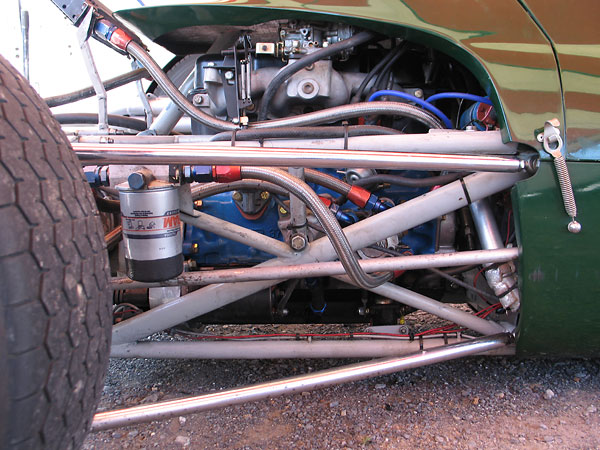
�
1.6L Ford Cortina four-cylinder engine.
�
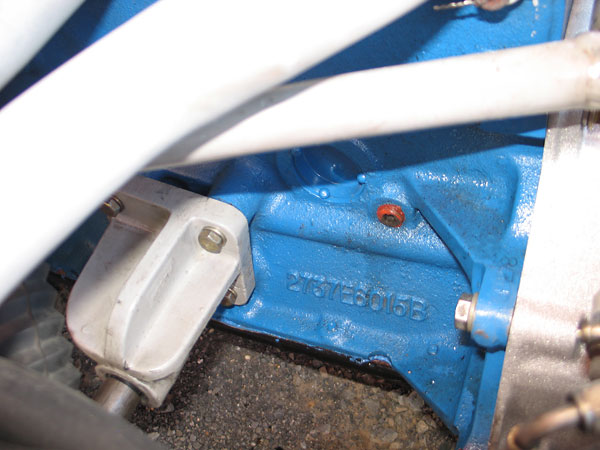
�
Engine block casting number 2737E6015B indicates that this is the early Cortina version of the Ford
�
Kent crossflow engine. One difference is that these earlier engines had compression cavities in the
�
cylinder head in combination with flat-top pistons. From about 1971 on, Ford built the engines with a
�
flat-surface cylinder head and dished pistons. The later engine is also figured to have a more
�
robust bottom end. Most racers of vintage Formula Fords have updated to the later design, but
�
Bob Romanansky's Macon MR7 still has a non-updated Cortina engine.
�
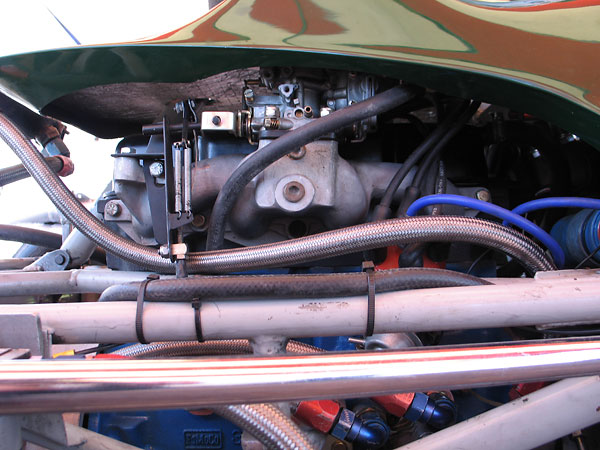
�
Weber 32/36 DGV carburetor.
�
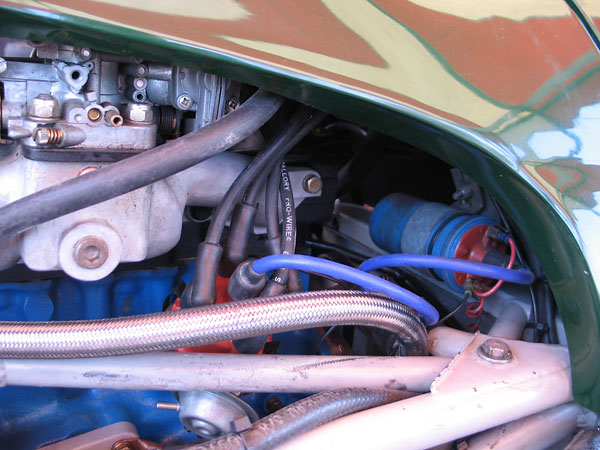
�
Bosch distributor, Bosch blue ignition coil, and Mallory Pro-Wire Silicone 8mm spark plug wires.
�
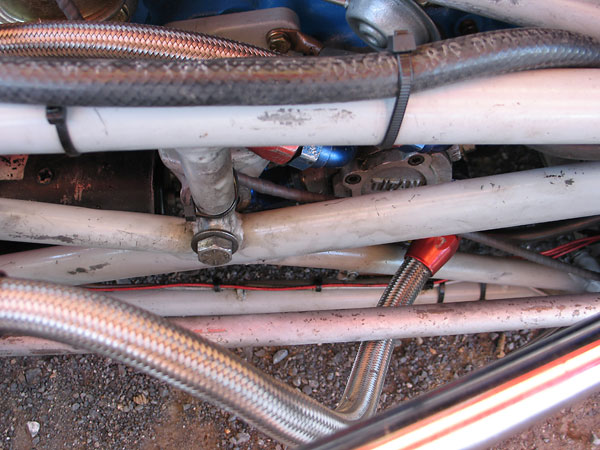
�
Titan oil pump.
�
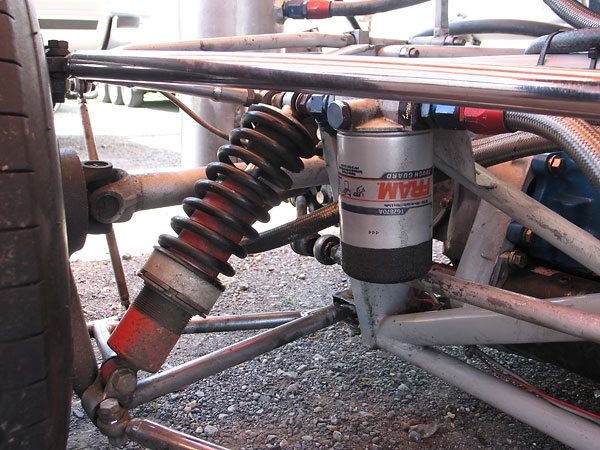
�
Fram Toughguard TG2870A engine oil filter mounted on a Mocal remote oil filter base.
�
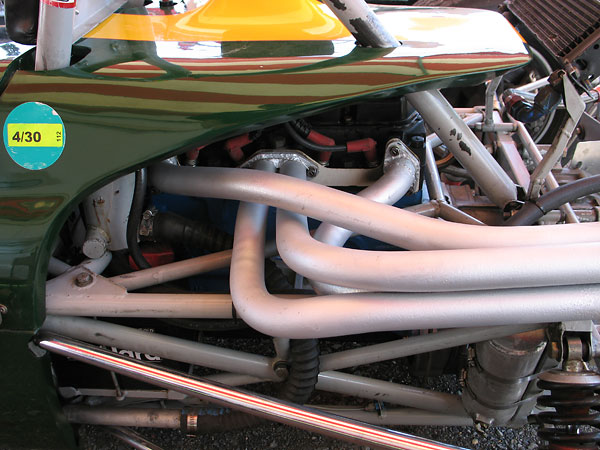
�
Four into one headers.
�
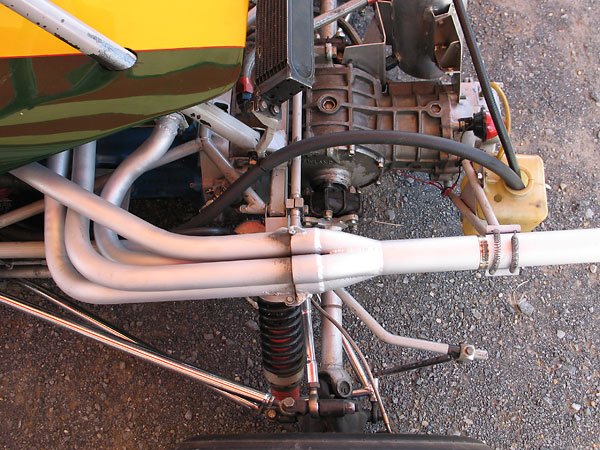
�
Note the lack of seams and the variety of bend radii in these headers. These are the real deal:
�
they were sand-bent. In other words, sections of mild steel tubing were packed tightly with dry
�
sand and then capped. (Vent holes were undoubtedly drilled to let hot air escape.) Then, the
�
tubes were heated up and bent around various sized bits of old pipe or tree-stump. Cool!
�
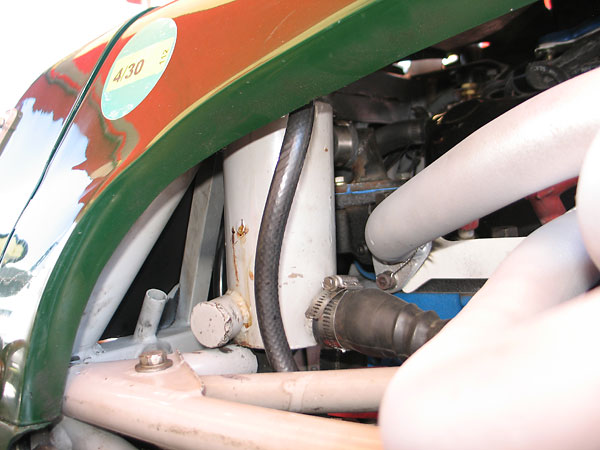
�
This tall coolant swirl pot helps separate air bubbles from coolant. Its original installation height
�
was about two inches lower as you can tell by the original port, which is now blanked off.
�
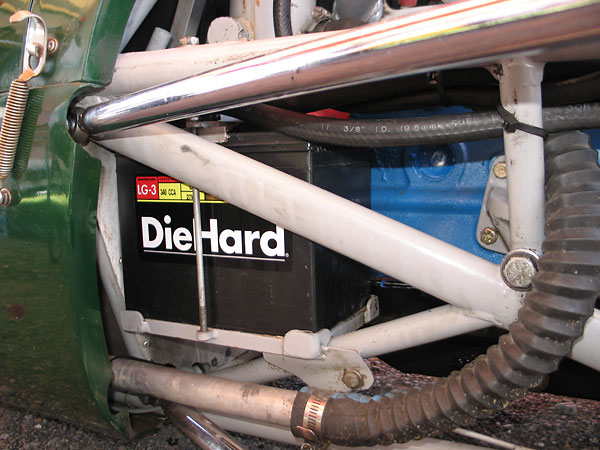
�
Sears DieHard LG-3 (lawn tractor) battery.
�
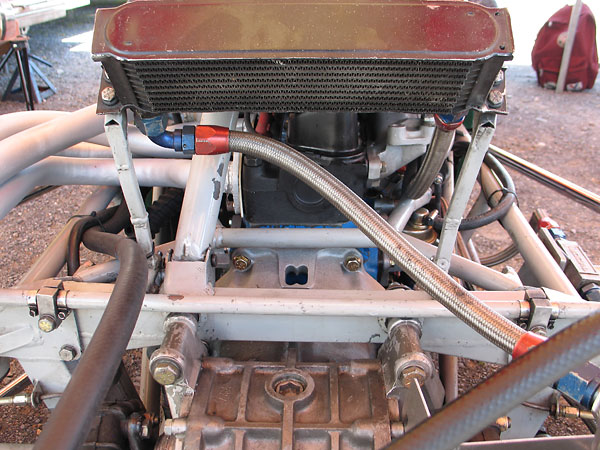
�
Setrab 10-row engine oil cooler.
�
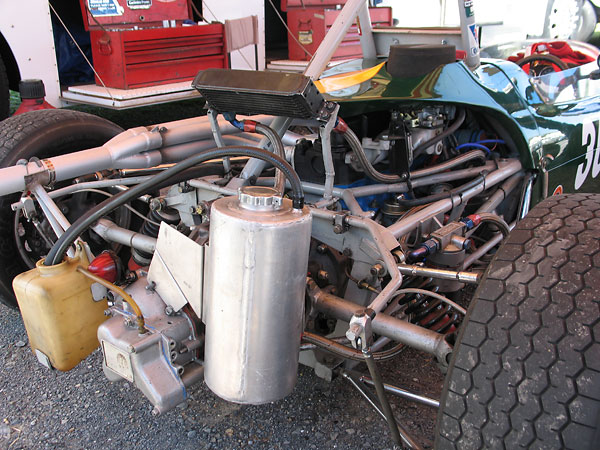
�
Original Macon fabricated aluminum engine oil reservoir.
�
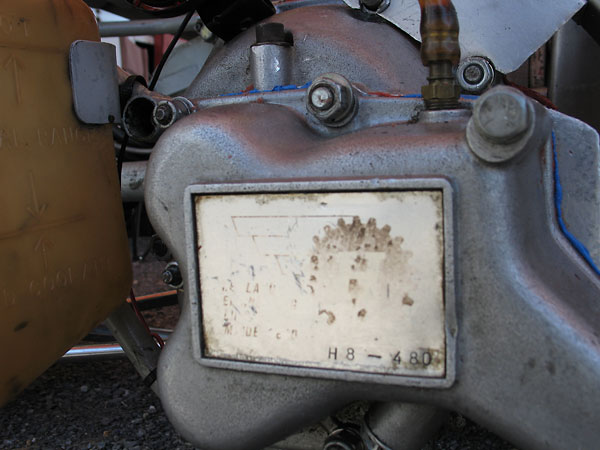
�
Hewland H8-480. This transaxle features a four speed gearbox.
�
�
Front Suspension
��
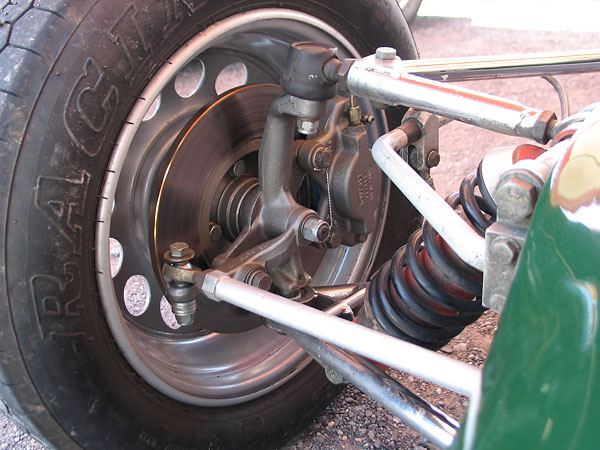
�
Triumph (Alford & Alder, forged) uprights and Girling 14L MkII brake calipers.
�
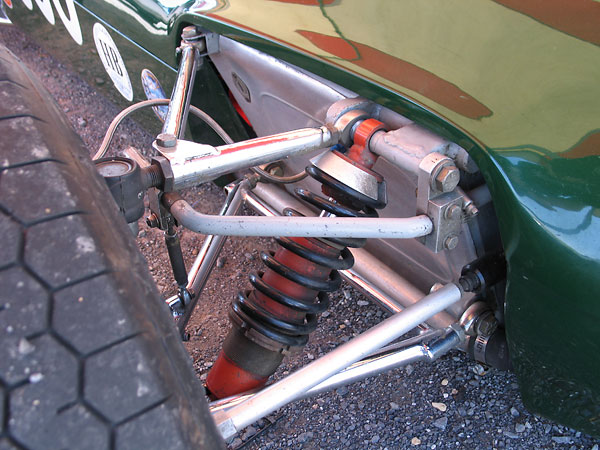
�
Unequal length wide-based wishbones... and all of the inboard attachment points are adjustable.
�
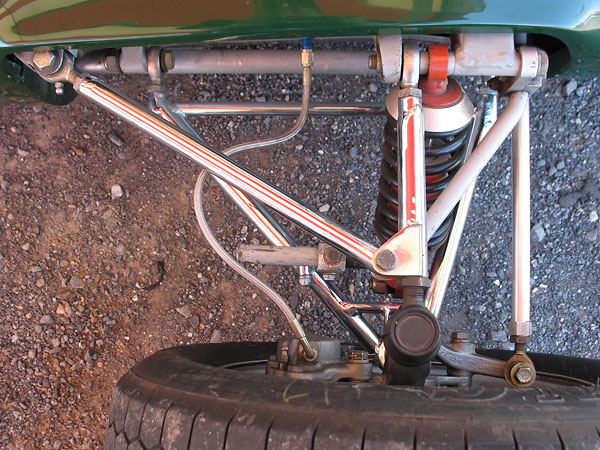
�
Two-piece upper control arms also simplify suspension tuning.
�
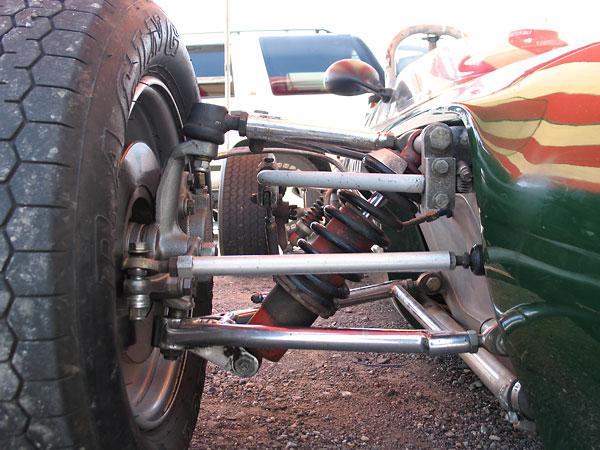
�
Koni steel bodied coilover shock absorber.
�
�
Enjoying this article? www.BritishRaceCar.com is partially funded through generous support from readers like you!
�
To contribute to our operating budget, please click here and follow the instructions.
�
(Suggested contribution is twenty bucks per year. Feel free to give more!)�
Rear Suspension
��
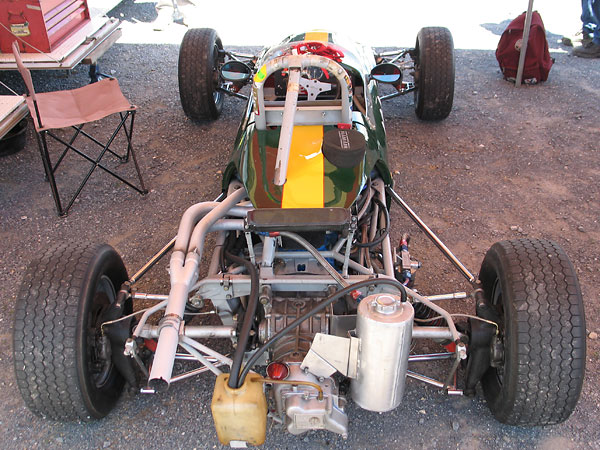
�
Inverted lower wishbones, single top links, and twin adjustable trailing links.
�
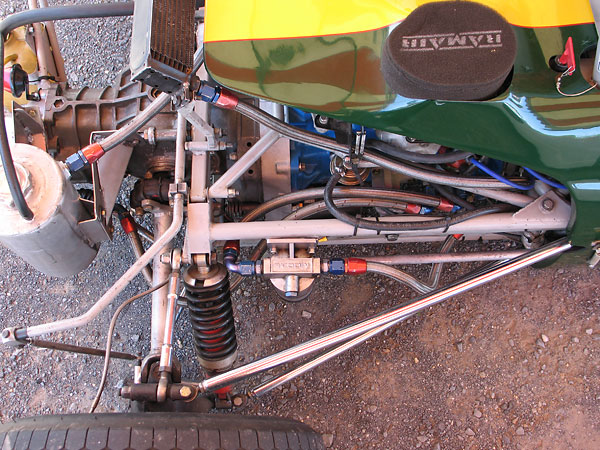
�
Metalastic rubber "doughnuts" on the halfshafts.
�
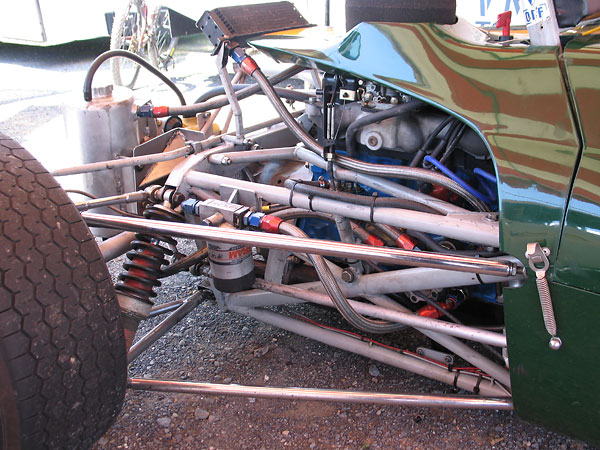
�
Widely spaced trailing links (in contrast to early Lotus Formula Fords.)
�
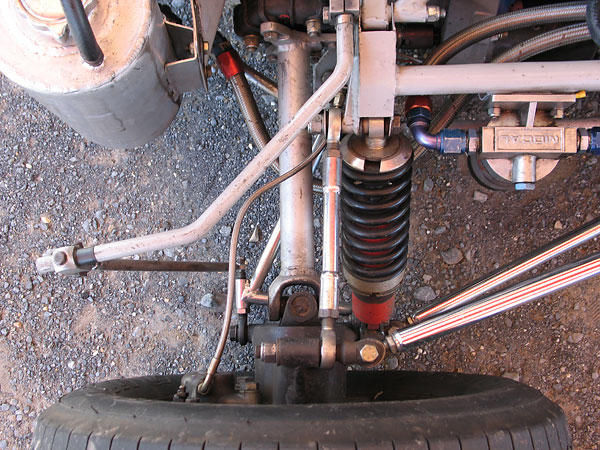
�
Macon was one of just a few small Formula Ford constructors to develop their own magnesium
�
rear uprights. Several other Formula Ford constructors purchased Macon's uprights for their
�
own cars including specifically Huron, Jamun, and Jomic.
�
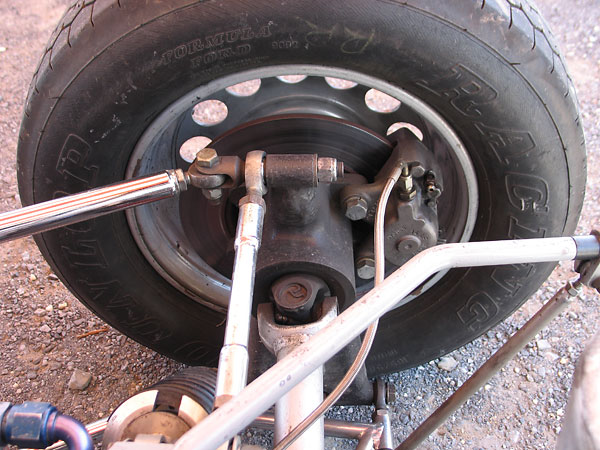
�
Proprietary Macon magnesium uprights and Girling 14LF MkIII brake calipers.
�
�
Interior
��
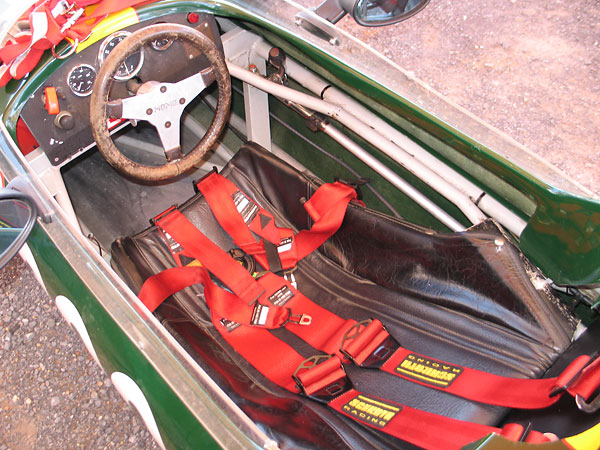
�
You want to step in and give it a try, don't you!
�
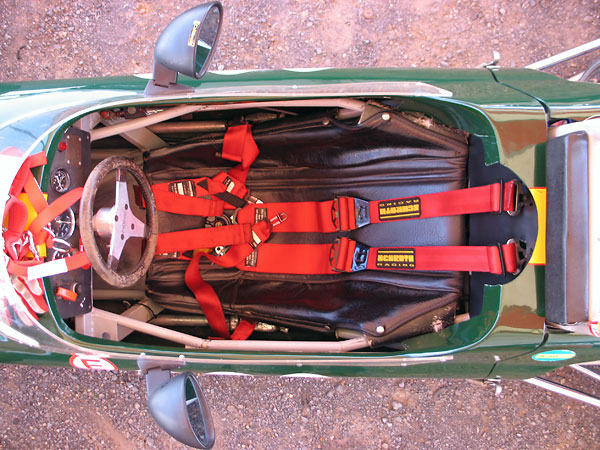
�
Schroth Racing six-point cam-lock safety harness.
�
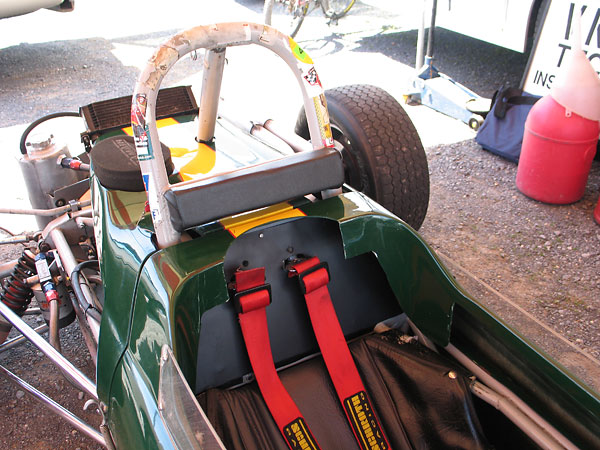
�
Roll hoop and head rest.
�
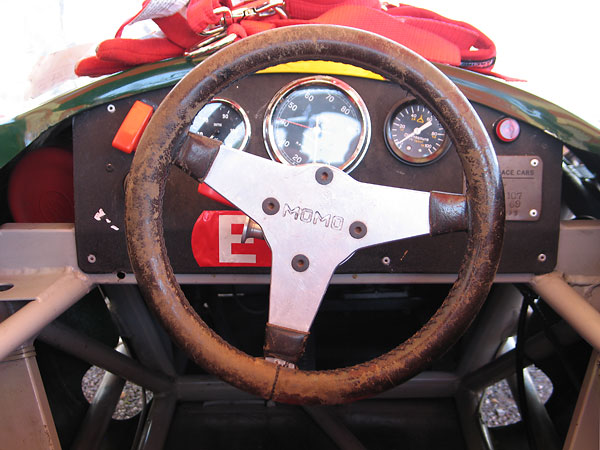
�
Vintage Momo steering wheel mounted on a quick release hub.
�
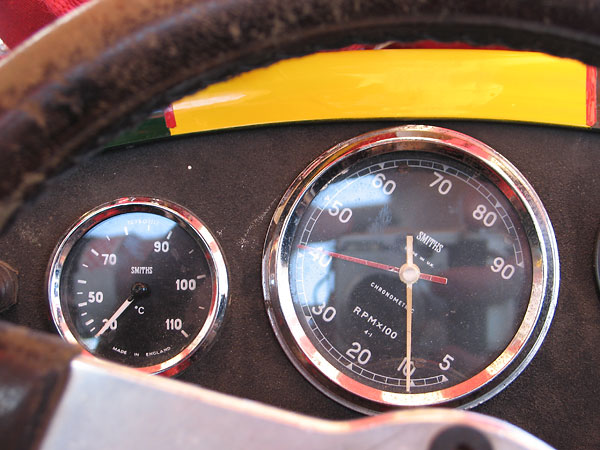
�
Smiths coolant temperature gauge (30-110C) and Smiths Chronometric rev counter (500-9000rpm).
�
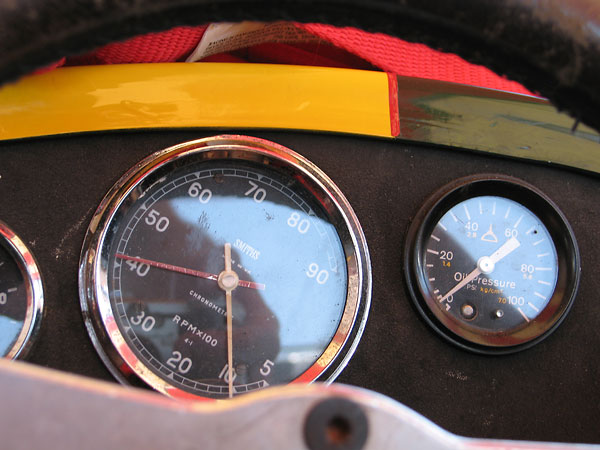
�
Smiths Chronometric rev counter (500-9000rpm) and oil pressure gauge (0-100psi).
�
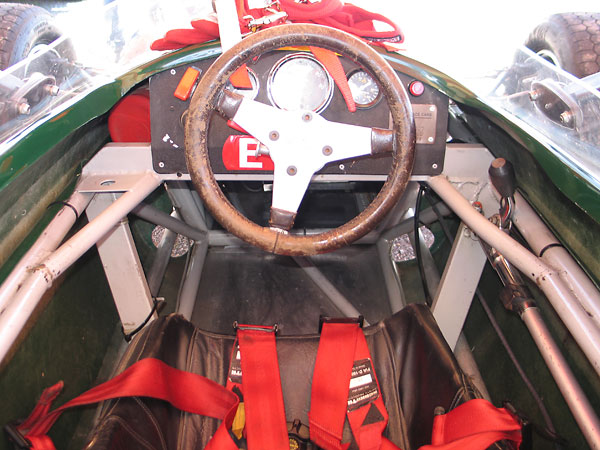
�
The scuttle is fabricated our of box tubing.
�
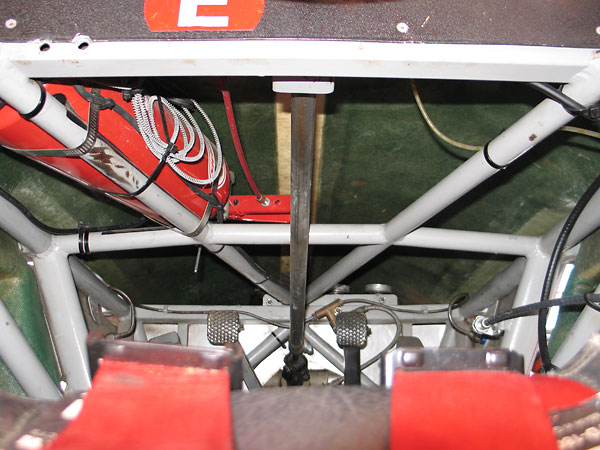
�
Apparently this car's yellow racing stripe was originally narrower.
�
Note also centralized fire suppression system and remote reservoirs for brake master cylinders.
�
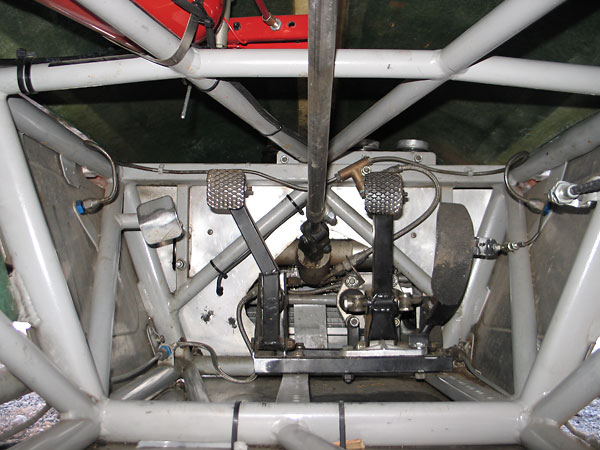
�
Rather than make having adjustable faces on the pedals, the complete pedal and master cylinder assembly
�
is mounted on a sled, and can be moved closer to the driver. The range of adjustment is huge!
�
(This is almost certainly NOT an original feature of the Macon design.)
�
�
Exterior
��
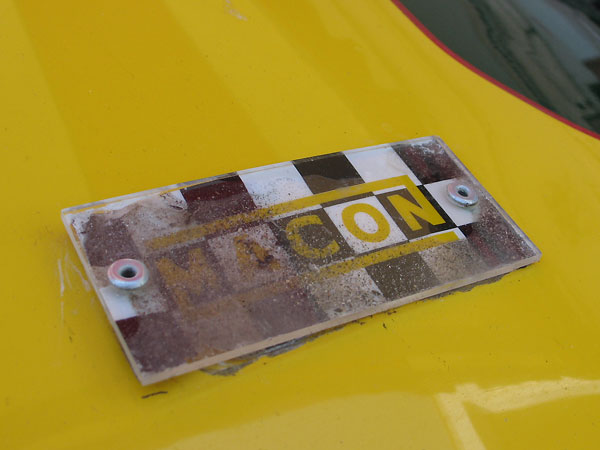
�
Macon Race Cars logo.
�
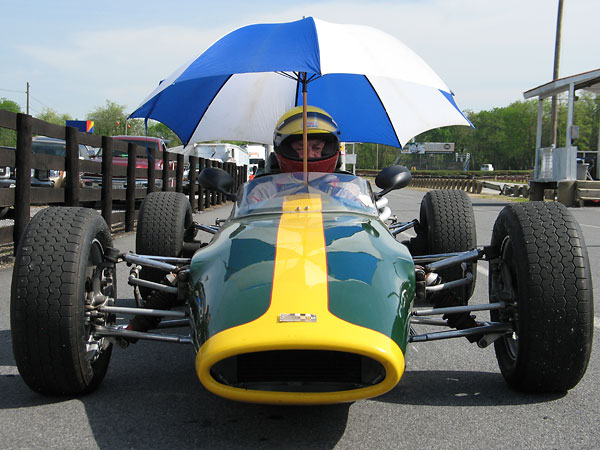
�
Bob Romanansky prepares to contest the Jefferson 500 at Summit Point.
�
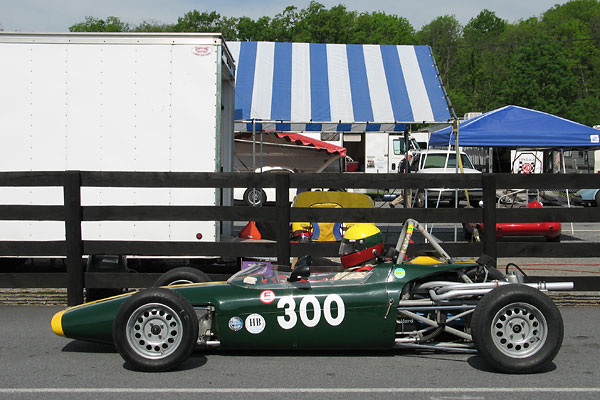
�
Fred Opert Racing became the North American distributor for Macon Race Cars, and ultimately
�
the company's most important customer. Complete cars were shipped to Opert, and also in some
�
cases kits which may have been assembled or used for spare parts.
�
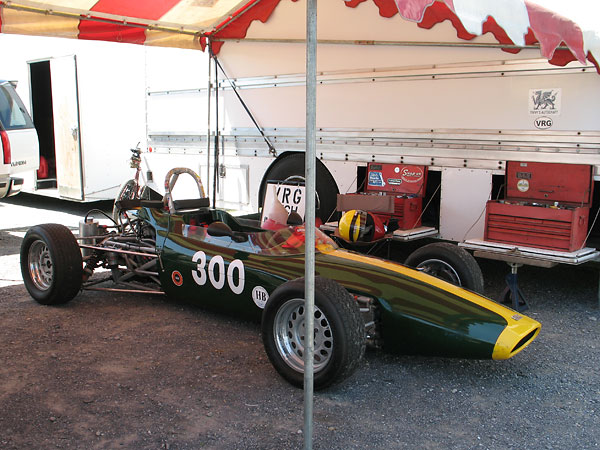
�
Macon's fiberglass bodies were produced by a company called Centaur of Southwold, Suffolk. The
�
mold Centaur used for the main body section was second hand. It had earlier been used for one of
�
the cars in the movie Grand Prix.
�
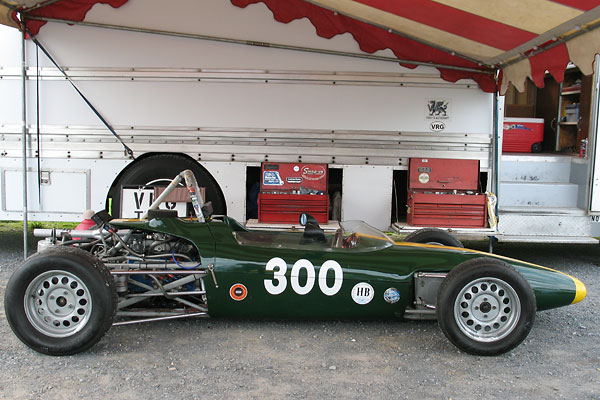
�
Before being sectioned and made narrower, the Macon MR6/MR7
�
body mold was used for producing McLaren's M4 model.
�
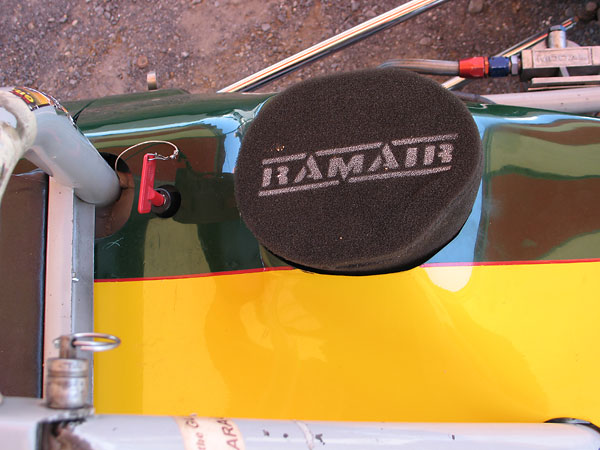
�
Hella battery disconnect switch. RamAir foam air filter.
�
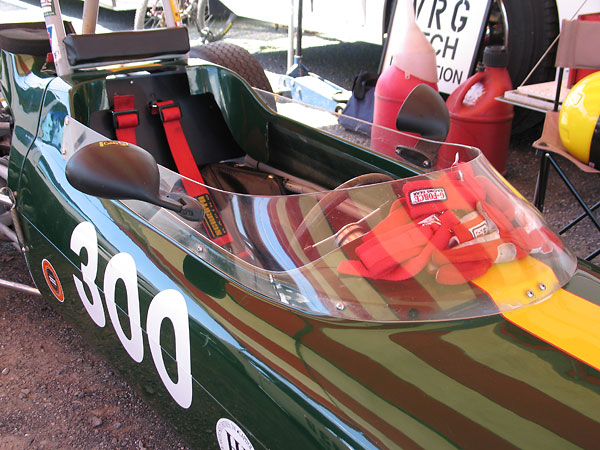
�
Wraparound Perspex windscreen. (Perspex is British-English for acrylic, a.k.a. "Plexiglas".)
�
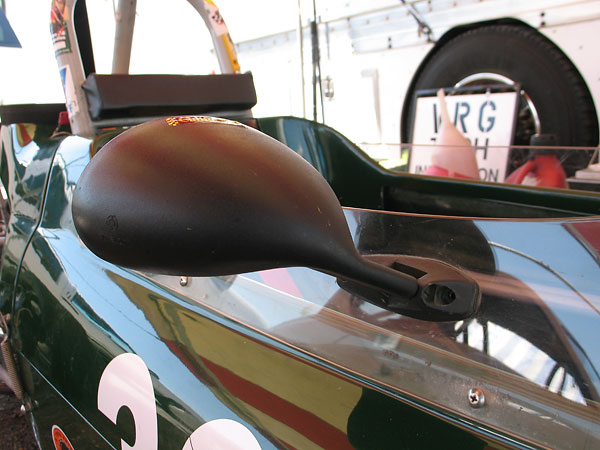
�
Vitaloni California mirrors.
�
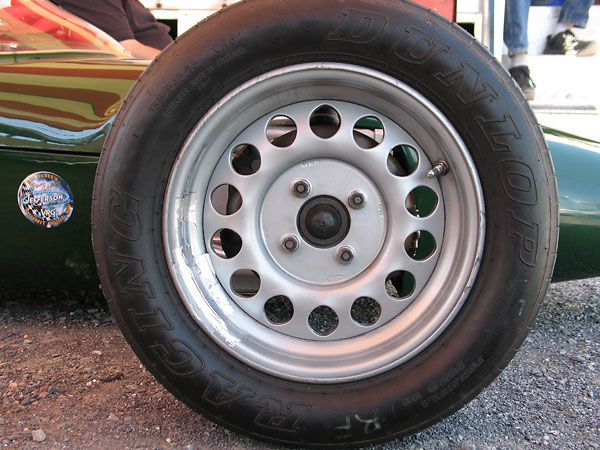
�
Weller Wheels 13x5.5 steel disc wheels (~12.6# each).
�
�
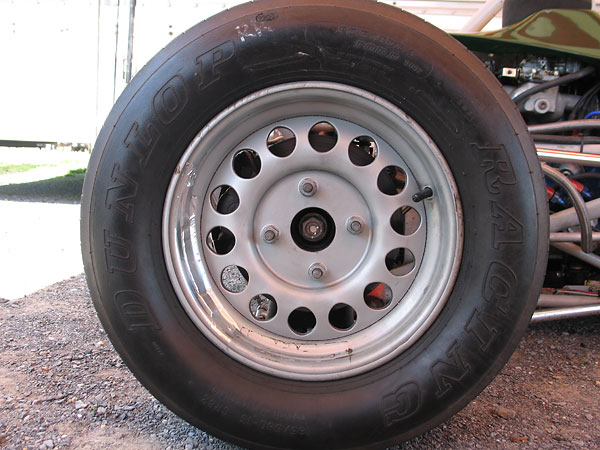
�
Dunlop Racing "Formula Ford" tires (135/545-13 CR82 front, 165/580-13 CR82 rear).
�
�
All photos shown here are from April 2010 when we viewed the car at VRG's Jefferson 500�
at Summit Point Motorsports Park, West Virginia. Photos by Curtis Jacobson for BritishRaceCar.com, �
copyright 2011. All rights reserved.
�
| If you liked this article, you'll probably also enjoy these: | �|||||
 | �
Jeff Snook 1968 Alexis Mk14 | �
 | �
Dick Leehr 1968 Lotus 51c | �
 | �
Dave Fairchild 1969 Merlyn 11A | �
| You're invited to discuss anything you've seen here on The British Racecar Motorsports Forum! | �|||||
�
Notice: all the articles and almost all the photos on BritishRacecar.com are by Curtis Jacobson.
�
(Photos that aren't by Curtis are explicitly credited.) Reproduction without prior written permission is prohibited.
�
Contact us to purchase images or reproduction permission. Higher resolution images are optionally available.
�

 �
�
 �
�